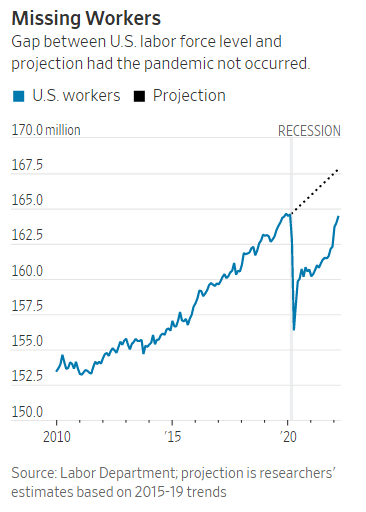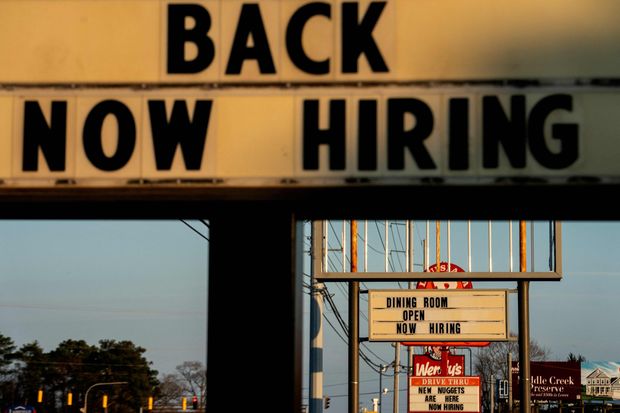Millions of workers refuse to go to work
There is no “miracle” for post-pandemic labor recovery
The labor shortage has contributed to slowing economic growth and pushing inflation to a 40-year high. Meanwhile, a new study cited by the WSJ shows that several million people who left the US workforce during the outbreak of the pandemic will not return to work because of fear of illness, physical deterioration, etc. This has the potential to cause labor shortages to last for years.
Accordingly, about 3 million people who have left the workforce say they will not return to pre-Covid-19 activities, whether going to work, shopping in person or eating out. Even when the pandemic is over, they will keep their current habits. Most of these are women, who are poorly educated and have to work in low-paid sectors.
The team has dubbed the phenomenon “prolonged social distancing” and believe it will be one of the longest-lasting scars of the Covid-19 pandemic.

Concern for his health led Mr. Lage to refuse to return to work.
Chuck Lage, 63, was among those who lost their jobs during the first two months of the spring 2020 pandemic. He was fired from his position as the business planning director of a nonprofit professional association. Suffering from an illness that makes his body unable to produce antibodies against the disease, Covid-19 made him decide to retire early and avoid all activities such as eating and socializing. Lage has no intention of changing this in the near future.
In the Facebook group for people with the same disease as himself, Mr. Lage knows that many people make similar decisions. “The world is coming back, but we are not yet,” Mr. Lage said.
People like Mr. Lage are at the center of one of the economy’s toughest puzzles: Will some adults re-enter the labor market once the pandemic is over? Meanwhile, employers are struggling to find workers to meet today’s strong consumer demand. The result was higher wages, one of the factors that pushed inflation to 8.5% in March, a four-decade high.
Stanford University economist Nicholas Bloom, who was part of the research team, said: “We don’t see a miraculous recovery in the workforce. We don’t see any indication that this group will ever return. On the contrary, that means the decline could be quite long.”
Pressure on the US economy and the Fed’s interest rate policy

America’s labor shortage after the Covid-19 pandemic.
If the researchers’ predictions come true, their impact on the US economy will be huge, along with pressure on the US Federal Reserve. The pandemic’s shrinking workforce has caused severe shortages of workers and products, stunting economic growth and pushing inflation to a 40-year high.
The workforce recovered significantly between March and April 2020, leaving 22 million people out of work and reducing the workforce by 8.2 million, or 5%. Even with the labor recovery in March 2022, despite bringing the labor force to 164.4 million people (a decrease of only 174,000 compared to before the epidemic), the US is still short of about 3.5 million workers.
This number represents the difference between the number of workers as of March and the number of workers that the US would have had at the same growth rate from 2015 to 2019, when there was no pandemic.
Each month for the past year, the team surveyed 5,000 people between the ages of 20 and 64 who earned at least $10,000 a year in the previous year. As a result, 1 in 10 respondents said they had no plans to return. During the first months of this year, when the Omicron variant raged, the number of people saying no increased by 13%.
The group concluded that about 3 million people would not enter the workforce to maintain social distancing. The data shows that Covid-19 fears are still a problem for some workers, although they are diminishing over time.

Household savings rose to a record high during the outbreak, as the Federal government issued stimulus checks and ramped up unemployment benefits. Some economists argue that laid-off workers will re-enter the workforce to cope with rising inflation as they have to spend their savings. But in reality, maybe not all.
The Fed is expecting a stronger increase in the labor force in its journey to bring inflation back to the 2% target without raising interest rates too sharply. The central bank believes that a larger pool of workers will ease pressure on employers to raise wages at a rate the Fed deems unhealthy in the long run.
The Fed has signaled plans to raise rates relatively quickly this year. However, Fed Governor Lael Brainard, who is awaiting confirmation from the US Senate to assume the position of Fed vice chair, said that the increase in the number of workers could be a windfall, cooling the need to raise interest rates aggressively. than.
at Blogtuan.info – Source: cafebiz.vn – Read the original article here



